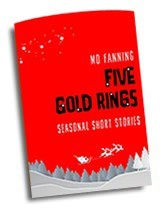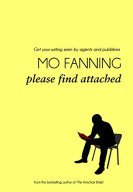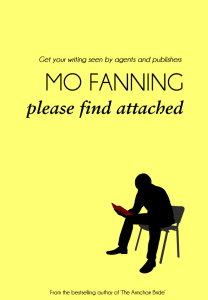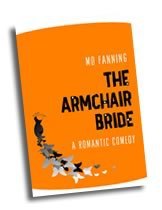Mo Fanning's Blog, page 19
December 28, 2017
The Director’s Cut
In 2006, I stumbled upon a website called YouWriteOn. It encouraged new writers to submit opening chapters for review. The highest-ranking stories went in front of editors from a major publishing house. My first attempts were (rightly) savaged. Some reviews were so awful that I thought of giving up. And then, one idea took flight. It won the professional nod, and the editor asked for more. It won me a literary agent and was in the running for Book of the Year.
In 2008, The Armchair Bride reached the top ten in the Amazon UK best-selling list. I made enough money to enjoy a very nice holiday and redecorate my flat.
YouWriteOn went the way of so many other peer review websites. The good writers left, and it became a den of talentless infighting. The literary agent lost interest when I failed to offer a second book in anything like the timescale imagined. My confidence crumbled, and I spent four years trying and failing to write something new.
In 2012, I pulled together a short story compilation. It helped sew the seeds for a return to writing. I began to let myself tell stories again, and stopped trying to play by rules that dictated what I could and couldn’t do. Free of writing for others, I did what I should have done all along – I returned to writing for myself.
I decided to write the kind of books I wanted to read.
Just last year, I decided to revisit my first book. I wanted to understand what worked for me then and why people liked what I wrote. The basics were there, but I cringed at the ‘period detail’. The Internet cafes, the fax machines, the admiring talk of a rare mobile phone. To be fair, the cross-dressing subplot needed work too.
And so, a rewrite of The Armchair Bride took hold. At first, just the odd line here and there, but before long, whole chapters went, new ones arrived and the main character evolved. Looking back, I wondered if she might be a little too needy, so I stiffened her spine and handed out sass.
It’s my ‘Director’s Cut’. A revamped Armchair Bride. The 2017 mix.
And if you read it before, please do me the honour of a second chance. If you loved it back then, I hope you’ll like it again. If you saw room for improvement, maybe you’ll agree I’ve done just that. Or perhaps you’ll consider it a load of pish. Either way, it’s free for the next few days.
If you stumble on this after it goes back up to full price, it’s hardly going to burn holes in your pocket, so if you’ve a day or two spare, give it a go, eh?
Online Lisa‘ runs a theatre box office in Manchester. She lives in Scandi-chic minimalistic bliss with her gay best friend. She’s sorted and she knows it.
‘Offline Lisa‘ stumbles from drunken-dating mishap to career-threatening dinner party.
Somewhat the worse for wear at a New Year staff party, Andy and Lisa resolve to change their lives. In the coming year, she’ll find love, and he’ll find fame.
Is her goal closer than she thinks?
Available online and in really good bookstores
The post The Director’s Cut appeared first on Mo Fanning.
December 22, 2017
The power of the flashback
You know how it goes. You’re watching a TV show, and all-of-a-sudden the scene changes. Flashback to five years earlier. If there’s one thing to be said for binge watching in the Netflix age, it’s that I’ve thought again about how I tell a story.
I’ve always known that a strict chronological timeline turns off the reader. Unless you’re an absolute master with a truly gripping story that evolves with every tick of the clock, you need to jump about a little when it comes to delivering back story. But, nearly every show I’ve watched this year employs flashback. Be it in the form of standalone episodes that focus on the motivation for one character, or juxtaposing scenes that find characters in better or worse situations in the past (or sometimes the future).
Writers have often used prologues to expose a key event in the past or future before diving into their story, and whatever you think of them, done right, they serve the reader well. In my latest book, I’ve taken the decision to cut up the story with flashbacks. They’ve appeared in a late edit. Until now, back story was delivered in discrete chunks, where the first person narrator recounted their logic to the reader. The temptation was always there to make these more detailed, but I knew it would damage the pace and flow.
Bite-size back story
I tried to slice motivation into bite-size pieces, but the natural story began to feel too much like a book, taking the reader out of the action. Early on in this edit, I experimented with a prologue, and then with a first flashback. I read it all back, and to my surprise found it worked. What I’d tried to do was tell the story as it unfolded, planted small, but non intrusive questions in the mind of the reader. Each flashback picked these up and allowed me to explain things. Free of the five-line limit that I self-impose on back story, I could go to town. Explain why someone might act as they do and inform their future motives.
I’m not sure I could have done this in the first or second draft. It takes a few goes before I feel I understand my characters enough to explore their past. My real worry was would I be hurting the pace by taking people out of the story. By keeping the chapter numbering for the present tale, and labelling each flashback as ‘Six years earlier’ or ‘Five years ago’, the sense of the story remained.
An early reviewer described my story-telling as episodic, and this feels like the next logical step to delivering on this.
How do you feel? Are you a chunk-feeder or ready to go the full flashback?
The post The power of the flashback appeared first on Mo Fanning.
December 19, 2017
A time …
A time to remember how it once felt
A time to regret those who left
A time to sit back and watch
A time to let yourself go
A time to forgive all that often annoys
A time to put others first
A time to endure for the sake of someone you love
A time to hold your tongue
A time to laugh at jokes you heard before
A time to not mention uncle Ted might be a racist
A time to drink sherry at ten in the morning
A time to hide the Monopoly board
A time to pretend that money is an acceptable gift
A time to watch ‘Carry on Abroad’
A time to collapse in relief when relatives get the hint and go
A time to suggest next year in Spain
Merry Christmas from Mo
FIVE GOLD RINGS is a collection of short stories set around the festive period. Some stories glitter and shine, others go dark. And brace yourself … there’s a story suitable for reading to children. No seriously, there is!
It’s FREE until December 23 at Amazon, and after that a very reasonable 99 pennies will secure your copy.
You’ll also get to read the first chapter of ‘The Toast of Brighton’ – so what are you waiting for? GET IT NOW.
The post A time … appeared first on Mo Fanning.
November 27, 2017
Project management for authors
There’s that Douglas Adams project management quote about loving deadlines. Especially the noise they make as they whoosh by. With less than two weeks to go before my Christmas short story book was due for release, I decided I wanted to cram in an extra story. You can imagine how this went down with my extremely patient editor. Equally, you can imagine how it went down with my partner when mentioned the extra editing cost.
But I was determined. I’d had an idea and I wanted it to feature.
Knuckle down
It got me to think about one thing that writers do particularly badly – project management. Given it’s a part of my actual day job, I ought to be able to deal with the intricacies of pulling together a bunch of work-streams and producing a product with consummate ease.
My next novel is due out in 2018. I’m trapped in the endless cycle of and rewrites with no push to knuckle down and accept that there must be an end point. To change this, I’ve decided to apply all that I do in real life to my authorly world.
A project manager knows they need to first work out what the customer wants. In this case, a well-written novel with a decent/credible plot, free of typos and crammed with conflict, a satisfying ending, and they want it all wrapped up with a lovely cover.
Each one of these ‘outputs’ has a work process.
I’ll address the stages over the coming days in my ‘Project Management for Authors’ blog series. Sign up to my mailing list now and hear about it first.
Five Gold Rings sprinkles the festive season with darkness and light. If you fancy a huge handful of tales that will get you through the yo-ho-ho, this is the one for you. There’s also a sneak peak of ‘The Toast of Brighton’. It’s an Amazon-only release and available 1 December.
sprinkles the festive season with darkness and light. If you fancy a huge handful of tales that will get you through the yo-ho-ho, this is the one for you. There’s also a sneak peak of ‘The Toast of Brighton’. It’s an Amazon-only release and available 1 December.
The post Project management for authors appeared first on Mo Fanning.
November 15, 2017
Writing tips: Hatches, matches and dispatches
As Australians vote to allow same-sex marriage, I got to pondering how, when writing, I often base stories around major life events. The Armchair Bride brings former enemies together. Having it all sees the bride flee a dream wedding. My next book will see Evie find new ways to cope when every familiar situation ‘dies’.
Our holy grail is a killer narrative arc, but too often we take this literally. As a beginner writer, I used to litter stories with subplots and feel the need to explain everything away by flashback and reference to what went before. I didn’t trust my reader to make up their own mind. Big mistake.
To hold attention, we create tension in our writing – a reason to read on. But we need to let the reader make up their own mind. The skill lies in planting the clues and shining the light on what we want seen.
The facts of someone’s life, presented end-to-end won’t excite the average observer. What matters is how we (or rather how our characters) tell their story. Not just to the reader and those around them, but how they relate events to themselves. And that’s always going to mean bias. Not that this is a bad thing. What matters is that your characters believe in what they do. Or if they don’t, they justify their actions.
Writing timelines
A powerful story rarely follows a straight timeline. As writers, we should feel empowered to pick apart a timeline and reassemble things, moving the emphasis onto key events. Often, these happen to be births, marriages and death. Not always literally. I’m not saying that no story will fly if there isn’t confetti. Birth might mean that a character becomes aware of being followed. A love affair can die. Rivals marry when they enter an uneasy alliance.
Strong narrative arcs don’t simply say what happened, they help the reader understand why it happened and why an event matters. They help the reader understand how the character moves from the first to the last page of a story.
Plotting
When it comes to planning a novel, some writers fill walls with Post-it notes, others compile volumes of research. The brave/foolish ones sit down with a blank document and see what happens. I’m a ‘seat of my pants‘ sort and tend to rely on minimal planning. That said, minimal doesn’t mean I get to completely ignore the timeline. When we tell any story, we need a firm grip on where things start and where (we think) they will end.
Something happens and it causes a situation that goes through every twist and turn until the something that happened either comes good, or dies and goes away.
And the things that happen might not be ‘major life events’ in the truest sense of the word, but to your characters, this is how they must be. Missing a train can be the birth of something that changes the course of a life. Starting a new job could lead to one relationship that kills another.
There might not be arguments about whose turn it is to change a nappy or sausage rolls at a wake, but hatches, matches and dispatches are the most powerful tools a story teller has. use them wisely.
The post Writing tips: Hatches, matches and dispatches appeared first on Mo Fanning.
October 27, 2017
Where to hunt a literary agent
This extract is from my latest ‘how to’ book aimed at new and developing writers – Please find attached – A guide to getting your work in front of agents and publishers. It’s available to download from today.
There are many ways to track down a literary agent. A sure-fire hit (and a book everyone tells you to buy) is the Writers’ & Artists’ Yearbook. It’s packed with listing for agents (and publishers), some giving advice on what they might be looking for and current client lists. There’s also an associated website. The book itself offers a range of advice articles and ‘state of the market’ summaries to help you bone up on what’s currently selling.
It’s long been the aspiring authors’ bible. The publisher of the Yearbook also offers a range of of ‘companion’ volumes that cover crime fiction, children’s fiction, life writing and historical fiction.
The problem with any reference book is that it goes out of date the second it leaves the printing press. The website is a good place to get a more current overview, but there are much better online tools out there to assist you in your search.
Websites to help find a literary agent
In the UK, I recommend Agent Hunter. If you’re in the US, stick to Agent Query (or Writer’s Market). None of these sites are free. They will expect a small sum in exchange for access to their market intelligence.
This is where you need to take care. There are plenty of insipid copies of the sites out there that don’t work as hard to offer up-to-date information. The ones recommended below have proved good for me (and writers I know).
Agent Hunter: http://www.agenthunter.co.uk/
First Writer: https://www.firstwriter.com/Agents/
Agent Query: https://agentquery.com/
Writer’s Market: http://writersmarket.com/
Create a hit list
Just like when job hunting, you wouldn’t write to every company in the phone book, don’t submit to every literary agent you find. Use the data and intelligence out there to filter your list. The better websites allow you to do just that. They’re updated to show which agents are looking to grow their lists. Use the search functionality on your chosen reference site to find:
agents who accept work in your genre
agents actively looking to grow their list
agents who make it a priority to work with new writers
Search and discover
Supplement your hit list by using any search engine, hunting agents on Twitter. Add to your list until you have a top five or six that you want to approach.
 Get your work seen by agents and publishers
Get your work seen by agents and publishersThere are plenty of books that teach you how to write – or write better. But then what? ‘Please find attached‘ is a guide for writers who are ready to submit their work to agents or publishers. It explains the role of an agent and the publishing process. It helps writers decide if self-publishing might work better. Along the way, there’s solid advice on how to write a killer query letter, tackle a synopsis that sells, and how to present your work at its best. Practical tips cover formatting and the etiquette of approaching an agent or publisher. It’s invaluable help that other guides tend to gloss over.
A must have for any writer ready to take the next step.
The post Where to hunt a literary agent appeared first on Mo Fanning.
October 18, 2017
Submitting to an agent – what not to say
 If you’ve reached the point where you think you’d like to find an agent or publisher for your writing, there’s plenty of advice online. My own book – Please find attached – is rammed to the rafters with tips on how to attract attention, write a query letter, synopsis, bio and generally convince the gatekeeper that you’re good enough to be let in.
If you’ve reached the point where you think you’d like to find an agent or publisher for your writing, there’s plenty of advice online. My own book – Please find attached – is rammed to the rafters with tips on how to attract attention, write a query letter, synopsis, bio and generally convince the gatekeeper that you’re good enough to be let in.
But what about the things you should really keep to yourself? There is such a thing as Too Much Information. The ‘good ideas’ that risk ruining everything. And if that happens, here’s some advice on dealing with rejection. So what do agents and publishers insist are their biggest turn-offs. How can you turn ‘maybe’ into ‘no’?
Don’t send your cover design. Even if you paid a lot of money for it and you know that it’s perfect. Writers get very little, if any, say on the cover design for their books at big publishing houses. Agents less so. Nobody needs it. Never send it.
Don’t try to stand out by writing the query letter in the voice of one of your characters. Professional is your touchstone. Quirky lives elsewhere.
When asked for a bio, don’t be tempted to attach a CV or beef up a few ideas into a puff piece. The one or two short lines in your query letter will be enough.
If you absolutely must include your publishing history, avoid mention of anything that might peg you as an amateur. This usually means flash fiction contests or other competitions run by unpublished authors, disreputable poetry contests or off-the-grid Who’s Who listings. Keep quiet about self-published books – unless you can prove you sold 20,000 copies. Sold, not gave away free.
When you talk about how your work might sit well with other writers, you’re doing it to show you’ve thought about marketing. It helps the agent or publisher understand how you see yourself fitting in. Don’t go too far with this. Never compare yourself directly with other great writers. You’re looking to prove you know how to ‘sit alongside’, not equal or better. Absolutely never say you’re the new anyone, and avoid claiming that your book is ‘just like’ an existing title. Who wants to read the same book twice?
On the subject of knowing your market, don’t claim your novel will appeal to everyone. It won’t. You need to prove you understand the market. A teenage boy and a retired businesswoman are unlikely to read the same books. Claiming wide appeal suggests you have no market in mind.
You might think your book would make a great movie. Hold that thought. And never talk about who you would cast in what role.
Rhetorical questions sound cheesy. Avoid them in your hook and query letter. Stick to the facts of your story and avoid clichés. Too much gameshow host smarm and you undo all the good.
Avoid insincere flattery. ‘I would be honoured if you could spare the time …’ Your query letter functions like a job application. Would you apply for work like this?
Don’t tell the agent or publisher that this is the first book you ever wrote. Inexperience is no turn-on. Equally nobody cares if you’ve been writing since you got into long trousers. ‘Writing is my dream‘ suggests you could well be a nightmare to represent. There’s little value in explaining how your friends, parents or probation officer loves the book – unless the have influential columns in the national press … or notoriety. The only opinion that matters is that of the agent or publisher reading your work.
And never ever slate other writers. It’s a guaranteed rejection.
Finally, it may be good to talk, but don’t for one minute think that calling an agent to pitch is going to end well. You’re a writer. Write!
 Get your work seen by agents and publishers
Get your work seen by agents and publishersThere are plenty of books that teach you how to write – or write better. But then what? ‘Please find attached‘ is a guide for writers who are ready to submit their work to agents or publishers. It explains the role of an agent and the publishing process. It helps writers decide if self-publishing might work better. Along the way, there’s solid advice on how to write a killer query letter, tackle a synopsis that sells, and how to present your work at its best. Practical tips cover formatting and the etiquette of approaching an agent or publisher. It’s invaluable help that other guides tend to gloss over.
A must have for any writer ready to take the next step.
The post Submitting to an agent – what not to say appeared first on Mo Fanning.
October 12, 2017
Rejected by a literary agent? You’re in good company
 Rejection can be crushing. There’s little joy when you receive an email that wishes you well but declares that your labour of love is ‘just not for me’. If you find yourself rejected, take comfort that you are not alone. I’ve pulled together a list of well-known writers who struggled to find a home for their words. I hope it offers comfort on the darker days. You might also consider vodka and cake.
Rejection can be crushing. There’s little joy when you receive an email that wishes you well but declares that your labour of love is ‘just not for me’. If you find yourself rejected, take comfort that you are not alone. I’ve pulled together a list of well-known writers who struggled to find a home for their words. I hope it offers comfort on the darker days. You might also consider vodka and cake.
Agatha Christie enjoyed five years of constant knock-backs. C. S. Lewis had all but given up before ‘The Chronicles of Narnia’ found a home. Beatrix Potter gave up trying after receiving rejection after rejection. She self-published and the rest is history. Margaret Mitchell received 38 rejections for ‘Gone With The Wind’.
J.K. Rowling eventually signed to the Christopher Little Agency. This was after being rejected by many others. Even then her agent received twelve rejection slips for the first ‘Harry Potter’ book.
Meg Cabot boasts that she kept all her rejection letters in a bag. Eventually, that bag became so heavy she couldn’t lift it. It didn’t stop her trying, and so the world got to read ‘The Princess Diaries’.
Paulo Coelho sold 800 copies of ‘The Alchemist’ until he found a better publisher who shifted 75 million copies.
‘I recommend that it be buried under a stone for a thousand years,’ was the rather mean (and in no way constructive) feedback provided to Vladimir Nabokov. His novel, ‘Lolita’ went on to sell around 50 million copies.
After 14 agents turned down Stephanie Meyer, she finally found one willing to champion ‘Twilight’. It spent 91 weeks on the New York Times best-seller list.
26 publishers rejected Madeleine L’Engle‘s novel, ‘A wrinkle in time’, before it became an award-winning best-seller. Audrey Niffenegger fared slightly better with 25 rejections for ‘The Time Traveller’s Wife’. 23 publishers and agents turned down ‘Dune’ when Frank Herbert sought publication.
They were in good company, James Joyce heard no 22 times when touting around ‘Dubliners’. Urban legend has it that Joseph Heller named his hit book ‘Catch 22’ in honour of the 21 rejections that came before a publisher finally said yes.
Major league rejection
After 60 rejections Kathryn Stockett finally had good news for her book ‘The Help’. Jason Wallace can beat that. 100 agents and publishers rejected ‘Out of Shadows’ – it went on to win the Costa Children’s Book award.
But the award for sticking at it when everyone suggested he should give up must go to Robert M. Pirsig. ‘Zen & the Art of Motorcycle Maintenance’ features in the Guinness Book Of Records. It received 121 rejections – more than any other best-seller.
And if you are a short story writer, take heart. The estate of best-seller Jack London in San Francisco, the House Of Happy Walls has a collection of some of the 600 rejections he received before selling a single story.
This article is an extract from my forthcoming book – Please find attached – A guide to getting your work seen by agents and publishers – due out later this month. Sign up to my mailing list and I’ll send you a discount code to get it half price.
The post Rejected by a literary agent? You’re in good company appeared first on Mo Fanning.
October 2, 2017
Writing great dialogue: Word of mouth storytelling
 Inexperienced writers tend to rely on dialogue to deliver the story. It’s an absolute no-no. Victoria Wood satirised this best in her mock soap ‘Acorn Antiques’:
Inexperienced writers tend to rely on dialogue to deliver the story. It’s an absolute no-no. Victoria Wood satirised this best in her mock soap ‘Acorn Antiques’:
“Apparently, being spiteful and having lots of extra-marital affairs could bring back my jaundice, so I’m going to be really nice from now on.”
The fancy word for this is ‘exposition’. Dialogue that exists for the supposed benefit of the reader.
‘John’s dead,’ she said.
‘John, our grandfather? The man who brought us up single-handed after our parents died in that terrible plane crash? That John?’
There’s no reason why your dialogue can’t help to set up the character of whoever it is who’s speaking, but when they’re filling in the reader, it doesn’t work.
‘I blame it on my upbringing. If my father hadn’t been abandoned by his mother at the age of six so she could go on a round the world cruise, I can’t help thinking things would have been very different,’ she said.
Show don’t tell and other dialogue dogma
The temptation to do this comes from another age-old writing rule: show don’t tell. Inexperienced writers imagine that by showing someone talking, they’re not telling. They’re wrong.
Ask yourself if anyone would actually deliver the line you just wrote.
Are they saying what they’re saying because you want to fill in detail?
And actually, there are times when you need to have a character recount the plot. Police procedurals are rife with it, but even then, it can come over tired.
When characters first meet they know nothing of each other. Unless you’ve set it up (which you could well do), the first time they talk, there’s no back story. They only know of their immediate situation.
As the scene unfolds, you can tease out a story, but trust your reader to pick up things you leave unsaid. You can add in story around the spoken word. Often you don’t need your characters to know everything about each other or the situation, but the reader may be getting an insider view.
‘I blame it on my upbringing,’ she said.
When he didn’t react, she found herself explaining how her parents split. How her father struggled to bring her up when her mother booked herself on a round the world cruise.
Rules for writing great dialogue
DON’T have characters tell each other things they should already know, never let them remind each other about things that happened in the past, just so the reader gets it.
NEVER have characters explain everything in horrible detail.
DON’T have characters tell each other how it makes them feel – or worse why (especially if it’s because of that awful thing in their past).
I’ve compiled a whole load of tips on writing dialogue into a free e-book, available to anyone who signs up to my mailing list. Or you can buy it online if you’d rather feather my nest with your hard-earned cash.
The post Writing great dialogue: Word of mouth storytelling appeared first on Mo Fanning.
September 13, 2017
Avoiding the laundry list
 ‘Laundry lists’ refer to writing where the author has tried to ram in as much detail as possible. Often because someone told them they needed to add ‘more description or setting’. You see it most when a new character wanders onto the page:
‘Laundry lists’ refer to writing where the author has tried to ram in as much detail as possible. Often because someone told them they needed to add ‘more description or setting’. You see it most when a new character wanders onto the page:
‘Ellie is tall, tanned, slim and very very blonde with big blue unblinking eyes that peer into your soul. She has such perfect skin and an obvious love of boho chic. Today, she’s paired grey Ugg boots with black shiny dance tights and added a pink ruffle skirt, topped off with a graphic print shirt. The overall look is of someone who got dressed in the dark. Her voice is raspy like someone who smokes many cigarettes, and she breathes heavily.’
Worse, it’s deployed when setting up a scene in a new location:
‘The cafe was dark and unwelcoming, the windows smeared with finger prints. The rickety tables had seen better days. None of the chairs matched and the floor was scuffed. Dog-eared menus sat between grubby salt and pepper shakers and the air was thick with the smell of greasy bacon. The counter itself was littered with yesterday’s free newspapers and in need of a good clean. A coat stand in the corner was overloaded with jackets. Red, blue, green, black and grey . . .”
In both cases, the reader is likely to lose interest fast, be overwhelmed and most likely have the writer pegged for a rank amateur.
When you talk to your friends, you don’t laundry list. You don’t take a deep breath and deliver a blow-by-blow account of the day you’ve had. Unless you’re in an absolute fouler of a mood, then you might.
And so it should be in your writing.
But first, let’s get one thing clear. Writing authentic dialogue isn’t the same as being able to scribe word for word what real people say. You’ll get no credit for jotting down that interesting conversation you overheard on the bus into town.
Real life dialogue is peppered with conversational ticks. And they should never make it into your story.
‘Hello,’ she said, as Monica sat.
‘Hello.’
‘How are you?’
‘Fine, thanks,. you?’
‘Great.’
‘Fabulous, right, so shall we get started?’
‘Yes, please.’
‘Great, then . . .’
But what if you do have a whole bunch of stuff you want to tease out in conversation? Again, the written word needs to work very differently to the real world. In a story, dialogue should move the story on, create or confirm conflict, keep the reader engaged. Monica and her friend’s greetings tell us nothing, move the story nowhere and as pleasant as it all may sound, you’ll tune out fast.
How about if things took a different turn?
Monica sat. Katie nodded hello.
‘How are you?’ she said.
The obvious answer would be that Katie felt awful. She hadn’t slept. She’d dreaded this meeting. But the truth wasn’t an option.
‘Fine,’ she said. ‘you?’
Monica shuffled papers.
‘Shall we get started?’
By adding in some action, a smidge of inner monologue and suggesting what lies beneath, there’s a story to be told.
Tuning out the ramble
In real life, when you talk to people, they’re more likely to respond to the first thing you say than the last. People latch onto initial words (or arguments) and prepare their answers. They tune out the rest of the ramble. It’s human nature.
In fiction again, things tend to work differently. Like I said above, dialogue exists to carry your story. And the writing needs to reflect that.
The average reader tends to carry the last words they’ve read into the next sentence, so rearrange the words spoken to allow each character to respond to the last line delivered.
That’s not to say you can’t have a character machine-gun ideas:
‘We need to clean the kitchen. Mum will be furious if she finds it like this. And the bedroom. One of us should make the beds and fluff up pillows. You know how fussy she gets about that. And have you seen the bathroom. It’s like a bomb went off. She’s going to go ape when she sees the dining room. Who let the dog in there anyway?’
‘Dude,’ I said. ‘Slow down. One thing at a time.’
Writing with a purpose
Did I mention already that dialogue should always help move your story along? Of course I did, because it’s the golden rule.
It’s a way to add depth to your characters and convey information. When your writing reaches the editing stage, ask yourself if a conversation adds anything. Would the story stand alone without it?
‘I saw Glenda at the beach,’ Tilly said.
‘Really?’
‘Yes, she was walking her dog.’
‘I didn’t know she had a dog.’
‘Yes, it’s a golden retriever.’
‘Fancy.’
Unless Glenda’s dog is going to play a vital role in a later scene, this sparkling exchange might need to go.
I’ve compiled a whole load of tips on writing dialogue into a free e-book, available to anyone who signs up to my mailing list. Or you can buy it online through all the usual places if you’d rather feather my nest with your hard-earned cash.
The post Avoiding the laundry list appeared first on Mo Fanning.





